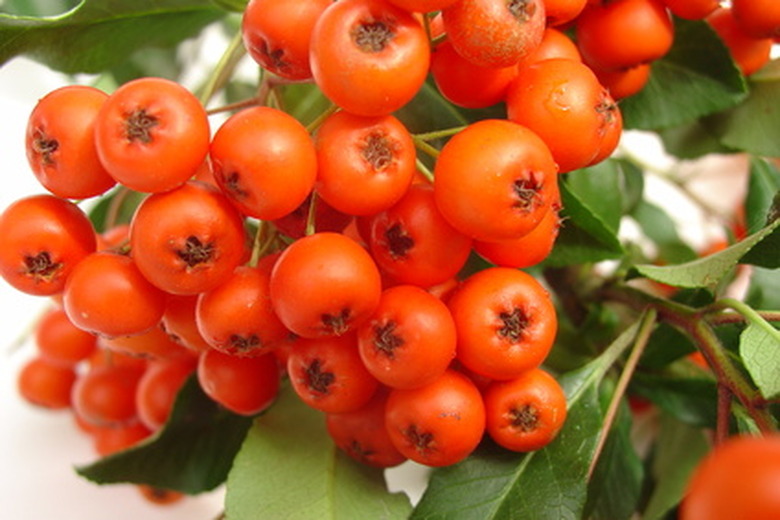How To Trim A Pyracantha Shrub
Pyracantha, or firethorn (Pyracantha coccinea), gives you a lot of bang for your landscaping buck and requires just a little regular pruning in return. The evergreen, which can be a free-standing shrub or trained against a wall or fence, not only gives you year-round foliage, but is covered in tiny white flowers in spring, followed by the main event — a big show of bright red-orange berries in the fall. Suitable for U.S. Department of Agriculture plant hardiness zones 6 through 9, the shrub grows from 6 to 18 feet tall in full sun to partial shade, and blooms on year-old wood, so prune after blooming for the best display.
Step 1
Step 1
Spray the blades of your pruning tools with household antiseptic cleaner to remove any lingering plant disease or fungus from plants you previously pruned. Wipe them dry with a paper towel. Clean your pruning tools every time you prune and between cuts when trimming a diseased plant, especially during the growing season.
Step 2
Step 2
Put on heavy gloves and wear long sleeves and pants — the plant isn't called firethorn for nothing; not only are the thorns long and sharp, they cause an itchy rash as well. The thorns do make it a good barrier plant though.
- Pyracantha, or firethorn (Pyracantha coccinea), gives you a lot of bang for your landscaping buck and requires just a little regular pruning in return.
- Put on heavy gloves and wear long sleeves and pants — the plant isn't called firethorn for nothing; not only are the thorns long and sharp, they cause an itchy rash as well.
Step 3
Step 3
Cut out dead or diseased shoots, or shoots that spoil the profile of the plant where they join the main trunk.
Step 4
Step 4
Go over the plant with handpruners in summer after the plant blooms and as the berries are forming, particularly a wall-trained firethorn. Remove the tips of side shoots that bloomed back to the young clusters of berries. This exposes the fruit so when they turn orange, you get the maximum impact.
Step 5
Step 5
Cut all the new side shoots of wall-trained firethorn — the ones that didn't bloom — back to just below a node 3 to 4 inches from the main branch. These shoots will bloom next year. This helps further expose the berries of the shoots that did bloom.
- Cut out dead or diseased shoots, or shoots that spoil the profile of the plant where they join the main trunk.
- This helps further expose the berries of the shoots that did bloom.
Step 6
Step 6
Clip back firethorn hedges selectively after the plant has put on its new summer growth. You can shear them, but may lose some of the berries. When pruning any hedge, cut so the top is narrower than the base of the plant to avoid shading out lower growth. Reach into the top and sides of the hedge at random spots along its exterior, and remove branches down to a side shoot to open up space for light and air. Formal hedges may need trimming two to three times over the summer.
Step 7
Step 7
Cut out any shoots affected by pyracantha scab or by fireblight. Plants with scab have black spots on their leaves and berries, while those with fireblight have blackened, hook-shaped tips. Cut 2 inches beyond fireblight damage into good wood, and sterilize your pruning tools between cuts.
- Clip back firethorn hedges selectively after the plant has put on its new summer growth.
- Reach into the top and sides of the hedge at random spots along its exterior, and remove branches down to a side shoot to open up space for light and air.
Step 8
Step 8
Cut the entire plant back to its woody framework or to whatever height you prefer in late winter to early spring if it has grown too large, is misshapen or is not longer blooming well. Firethorn responds well to dormant-season renovation pruning, though you will not get flowers or berries until the following year.
Tip
Showy firethorn berries are considered safe around children and pets, unless huge quantities are eaten. Warn children of the thorns, though.
Tip
Freestanding firethorn shrubs are commonly left alone except for a spring cleanup as in Step 3, as needed.
Tip
Train a firethorn onto wires or a trellis, so it forms a central trunk with horizontal lateral branches coming off each side in a series of "T" shapes. Prune off any shoots coming off the main trunk where you don't want them, and tie or twine the laterals around horizontal wires or tie them up. Shoots and flowering spurs form along the laterals.
Things Needed
- Heavy gloves
- Loppers
- Hand pruners
- Household antiseptic cleaner
- Paper towels
References
- Missouri Botanical Garden: Pyracantha Coccinea
- Pruning Plant by Plant; DK Publishing
- Washington State University Extension: Myth of the Cloroxed Clippers
- The Children's Hospital of Philadelphia: Poison Control Center — Berries and Seeds
- Royal Horticultural Society: Pyracantha
- The Complete Book of Pruning; Peter Blackburn-Maze, et al.
- PennLive.com: Pruning Pyracantha
- Nancy Brachey's Guide to Piedmont Gardening; Nancy Brachey
